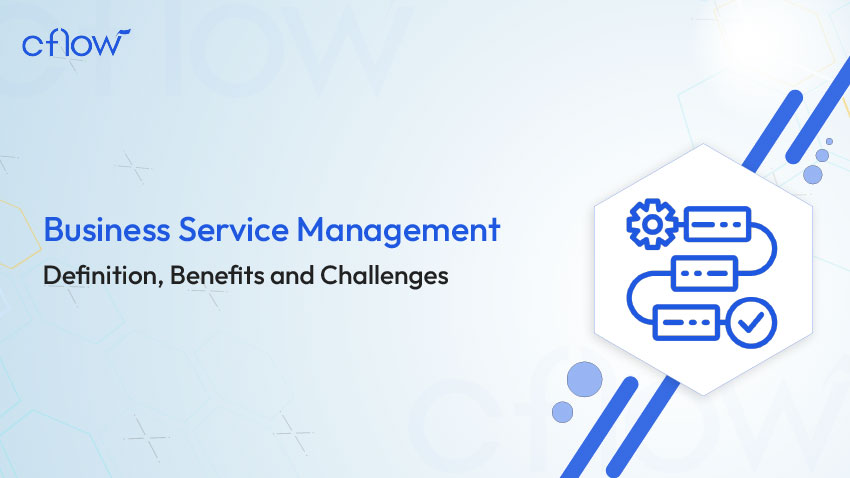What is Business Service Management (BSM) and How Does it Work?


Cflow Team
Share this Content
Key takeaways
BSM aligns IT with core business objectives, ensuring that technology supports customer value and strategic goals.
Key components of BSM include SLAs, ITIL frameworks, real-time monitoring, and continuous service improvement.
BSM has evolved from infrastructure-focused practices to customer-centric, AI-powered, and cloud-based solutions.
Emerging technologies like 5G, IoT, AI, and blockchain are reshaping BSM in the UK by enabling real-time, data-driven service models.
Automation and AI streamline service delivery, reduce downtime, and boost decision-making with predictive insights.
Cloud-based BSM solutions are ideal for UK enterprises seeking scalability, cost-efficiency, and regulatory compliance.
Implementing BSM successfully requires collaboration, stakeholder alignment, skilled personnel, and change management.
Cflow enhances BSM by providing an intuitive no-code platform that unites business and IT teams through workflow automation.
Organisations are under increasing pressure to align their IT services with broader business objectives. Business Service Management (BSM) plays a crucial role in bridging this gap, ensuring technology isn’t just a support function, but a strategic asset. Whether you’re a financial services firm in London or a healthcare trust in Manchester, BSM helps UK enterprises optimise service delivery, improve operational agility, and meet compliance standards like Cyber Essentials, GDPR, and ISO/IEC 20000.
With remote work, cloud adoption, and AI automation becoming the new norm, UK businesses must modernise their service management frameworks. BSM enables this by providing a holistic view of services, aligning technology with business goals, and enhancing the customer experience. In this blog, we’ll explore what Business Service Management is, how it’s evolved, and why tools like Cflow are essential for UK organisations aiming for seamless, efficient, and future-ready service delivery.
Table of Contents
Understanding Business Service Management
Business Service Management (BSM) is a comprehensive approach that integrates IT services with overall business objectives. It aims to create a seamless connection between technology infrastructure and business processes, ensuring that IT services directly contribute to organisational success.
Definition and Core Concepts
At its core, BSM is a strategy that aligns IT services with business goals, focusing on delivering value to customers and stakeholders. The primary concepts include:
- Service-oriented approach: Viewing IT as a service provider to the business
- End-to-end visibility: Monitoring and managing the entire service lifecycle
- Business-IT alignment: Ensuring IT initiatives support business objectives
- Continuous improvement: Regularly assessing and enhancing service quality
The Evolution of BSM in Modern Business
BSM has evolved significantly over the years, adapting to changing business landscapes and technological advancements. Key milestones include:
| Era | Focus | Key Developments |
| Early 2000s | IT-centric approach | Emphasis on infrastructure management |
| Mid-2000s | Service-oriented approach | Introduction of ITIL and service catalogues |
| 2010s onwards | Business-IT integration | Focus on digital transformation and customer experience |
Key Components of Business Service Management
The key components of Business Service Management (BSM) are vital for maintaining this alignment and creating a seamless, transparent, and resilient IT service ecosystem that meets business needs. These components work together to provide structure, streamline communication between IT and business units, and ensure that services are delivered reliably and effectively. Understanding and implementing these components is essential for organisations looking to leverage IT to drive business success.
Effective BSM implementation relies on several crucial components:
Service Level Agreements (SLAs)
SLAs are contractual commitments between IT service providers and their customers, defining:
- Service quality expectations
- Performance metrics
- Response times
- Penalties for non-compliance
IT Infrastructure Library (ITIL) Integration
ITIL provides a framework for IT service management, offering best practices for:
- Service strategy: Aligning IT services with business needs
- Service design: Creating efficient and effective IT services
- Service transition: Managing changes and releases
- Service operation: Ensuring smooth day-to-day operations
- Continual service improvement: Enhancing service quality over time
Discover why teams choose Cflow
Performance Monitoring and Analytics
Robust monitoring and analytics tools are essential for:
- Real-time performance tracking
- Identifying bottlenecks and issues
- Predicting potential service disruptions
- Generating insights for continuous improvement
Implementing BSM: A Structured Approach
Implementing Business Service Management (BSM) requires more than just adopting a new set of tools—it’s about rethinking how IT and business teams collaborate to achieve organisational goals. The implementation process should be structured and strategic, focusing on aligning IT services with core business objectives while ensuring smooth service delivery. A well-executed BSM strategy allows companies to streamline their processes, improve service quality, and create a resilient IT ecosystem that directly supports business outcomes.
Successful BSM implementation requires a systematic approach:
Assessing Current Business Processes
Begin by evaluating existing processes to:
- Identify pain points and inefficiencies
- Map current service delivery workflows
- Determine areas for improvement and optimisation
Aligning IT Services with Business Objectives
This critical step involves:
- Collaborating with business stakeholders to understand their needs
- Defining clear, measurable IT service objectives
- Creating a roadmap for service improvement and innovation
You can get started with Cflow for free
Leveraging Technology in BSM
Modern BSM relies heavily on advanced technologies to enhance service delivery and management:
- Artificial Intelligence (AI): For predictive analytics and automated issue resolution
- Machine Learning: To improve service quality and efficiency over time
- Cloud Computing: Enabling scalable and flexible service delivery
- Internet of Things (IoT): For comprehensive monitoring and data collection
Automation and AI in Service Management
Automation and Artificial Intelligence (AI) are revolutionising Business Service Management (BSM) by streamlining processes and enhancing decision-making. Intelligent automation reduces manual tasks, minimises errors, and accelerates service delivery. AI-powered chatbots and virtual assistants provide 24/7 support, improving customer satisfaction. Machine learning algorithms analyse vast amounts of data to predict potential issues and optimise resource allocation.
- Predictive maintenance: AI identifies potential system failures before they occur, reducing downtime.
- Automated ticket routing: Intelligent systems direct service requests to the most appropriate team or individual.
- Self-healing systems: AI-driven solutions automatically resolve common issues without human intervention.
Cloud-based BSM Solutions
Cloud-based BSM solutions offer scalability, flexibility, and cost-effectiveness. These platforms enable organisations to manage their IT services and business processes from anywhere, facilitating remote work and global operations. Key advantages include:
| Advantage | Description |
| Scalability | Easily adjust resources based on business needs |
| Cost-efficiency | Reduce infrastructure and maintenance costs |
| Accessibility | Access services and data from any location |
End-to-end workflow automation
Build fully-customizable, no code process workflows in a jiffy.
Benefits and Challenges of Business Service Management
Business Service Management (BSM) offers significant benefits for organisations, but it also comes with its share of challenges. On the one hand, BSM enhances operational efficiency by aligning IT services with business objectives, streamlining processes, and improving resource allocation. This leads to cost savings, reduced downtime, and better overall service quality.
Implementing BSM offers numerous benefits but also presents challenges that organisations must address to ensure successful adoption.
Improved Efficiency and Cost Reduction
BSM significantly enhances operational efficiency and reduces costs through:
- Streamlined processes: Eliminating redundancies and optimising workflows.
- Resource optimisation: Allocating IT resources more effectively based on business priorities.
- Reduced downtime: Proactive issue resolution and improved service availability.
These improvements lead to tangible cost savings and increased productivity across the organisation.
Overcoming Implementation Hurdles
Despite its benefits, implementing BSM can be challenging. Common hurdles include:
- Resistance to change: Employees may be reluctant to adopt new processes and technologies.
- Integration complexities: Aligning existing systems and processes with BSM frameworks can be technically challenging.
- Skill gaps: Organisations may lack the expertise required to implement and manage BSM effectively.
To overcome these challenges, organisations should focus on change management, provide comprehensive training, and consider partnering with experienced BSM consultants.
Understanding both the advantages and potential hurdles of BSM is crucial for successful adoption, as organisations must be prepared to overcome challenges like resistance to change, integration complexities, and potential skill gaps. By addressing these factors proactively, businesses can fully leverage the benefits of BSM to drive efficiency and innovation.
Try Cflow for free, no credit card needed
Future Trends in Business Service Management
As technology continues to evolve, so too does the landscape of Business Service Management (BSM). Future trends in BSM are being shaped by advancements in emerging technologies like 5G, the Internet of Things (IoT), Artificial Intelligence (AI), and blockchain, all of which promise to revolutionise how IT services are delivered and managed. These trends are driving the digital transformation of businesses, enabling faster, more agile service delivery, enhanced security, and better data-driven decision-making.
Additionally, the ongoing shift toward cloud-based solutions and automation means that BSM will play an increasingly pivotal role in helping organisations remain competitive, responsive, and innovative. To stay ahead, businesses must keep an eye on these trends and continuously adapt their BSM strategies to incorporate new tools and technologies that enhance their service capabilities and improve business outcomes.
Emerging Technologies and Their Impact
Several technologies are poised to revolutionize BSM:
| Technology | Impact on BSM |
| 5G Networks | Enable faster, more reliable service delivery and real-time monitoring |
| Internet of Things (IoT) | Enhance data collection and analysis for improved service management |
| Blockchain | Improve security and transparency in service transactions and agreements |
The Role of BSM in Business Process Management
BSM plays a crucial role in driving digital transformation by:
- Aligning IT with business goals: Ensuring technology investments support overall business objectives.
- Enabling agility: Facilitating rapid adaptation to changing market conditions and customer needs.
- Fostering innovation: Providing a framework for experimenting with new technologies and service models.
As organisations continue to evolve, BSM will remain a critical component in managing the complex interplay between technology, processes, and business outcomes.
Transform your AI-powered approvals
Elevating Business Service Management with Cflow
Managing efficient and cost-effective business services isn’t easy. It takes planning, teamwork, and making sure resources are used wisely. Cflow makes business service management simpler by bringing everything together in one platform. With Cflow, business teams can easily handle their workflows, track requests, and stay flexible. IT teams keep everything running smoothly by setting standards and reinforcing security.
Using Cflow as part of your BSM strategy means you can manage services more efficiently, stay agile, and keep both business and IT objectives aligned. It’s not just about improving processes; it’s about making sure your organisation is ready to tackle challenges and seize opportunities with the right support in place. With Cflow, BSM becomes a natural part of how you work, helping you grow and thrive.
Conclusion
Business Service Management isn’t just a technical strategy; it’s a business necessity. By aligning IT services with core business objectives, BSM empowers organisations to deliver better service quality, adapt to change faster, and meet stringent compliance standards like GDPR and ISO. Whether you’re navigating remote work challenges, managing hybrid infrastructure, or preparing for digital transformation, a robust BSM strategy can make all the difference.
Tools like Cflow provide the agility and automation needed to bring IT and business goals into harmony, without added complexity. From real-time monitoring to AI-powered workflows, Cflow helps you stay in control, reduce downtime, and make smarter decisions. For UK businesses aiming to scale, remain compliant, and stay competitive, BSM is not just a best practice; it’s a future-proof investment.
Frequently Asked Questions
1. What is Business Service Management (BSM)?
Business Service Management is a strategy that aligns IT services with business goals, ensuring that every aspect of IT delivery contributes to organisational success. It involves service monitoring, performance optimisation, and collaboration between IT and business units.
2. Why is BSM important for UK businesses?
For UK organisations navigating digital transformation, BSM ensures compliance with regulations (like GDPR), boosts operational efficiency, and supports business agility. It bridges the gap between technology and business strategy, making services more accountable and outcome-driven.
3. How does Cflow support Business Service Management?
Cflow provides a no-code automation platform that enables UK businesses to streamline workflows, enforce standards, and track performance. It empowers both IT and business teams to collaborate effectively, ensuring seamless service delivery aligned with strategic objectives.
4. What challenges are involved in implementing BSM?
Common challenges include resistance to change, integration with legacy systems, and a lack of skilled professionals. Overcoming these requires proper training, stakeholder buy-in, and potentially partnering with BSM experts or platform providers.
5. How is AI used in Business Service Management?
AI powers predictive maintenance, intelligent ticket routing, chatbots, and self-healing systems. It helps reduce downtime, automate repetitive tasks, and provide insights for continuous improvement.
6. Are cloud-based BSM solutions secure for UK enterprises?
Yes. Reputable cloud-based BSM solutions offer advanced encryption, access controls, and compliance with UK data protection laws, including GDPR and ISO standards. Cflow, for instance, integrates top-tier security features for safe and scalable deployment.
Related Articles
- Smart Solutions to Increase Productivity for SaaS Business Growth
- Importance of Process Mapping for A Successful EHR Implementation
- What is the Difference Between Process Management System and Business Management?
- What Business Process Management Statistics Experts Want You to Know
- A Comprehensive Look at the Different Types of Operations Management
What should you do next?
Thanks for reading till the end. Here are 3 ways we can help you automate your business:

Do better workflow automation with Cflow
Create workflows with multiple steps, parallel reviewals. auto approvals, public forms, etc. to save time and cost.

Talk to a workflow expert
Get a 30-min. free consultation with our Workflow expert to optimize your daily tasks.

Get smarter with our workflow resources
Explore our workflow automation blogs, ebooks, and other resources to master workflow automation.
Get Your Workflows Automated for Free!

